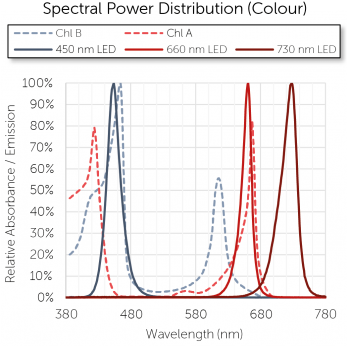A one size fits all approach is rarely the best solution, and when it comes to lighting for horticulture, agriculture, and vertical farming that is definitely the case.
Whilst LED grow lights have been available on the market for over 10 years there is still a great deal of research being undertaken on how to capitalise on the benefits of LED and harness the potential of the technology for use with different plant species.
With LEDs, it is possible to create luminaires that have a fixed wavelength output, whether that is white full-spectrum LEDs or a prescribed mix of monochromatic LEDs, or indeed create grow lights that can be adjusted to provide varying wavelength compositions over the various phases of a plant’s development from seedling through to flowing or cultivation.
The directionality of LEDs also makes them ideal for use with optical systems to put light exactly where you need it in your growing environment. Indeed, with the use of bespoke optics, it is possible to have a common light engine that can be used in a top-lighting situation with one optic configuration and then an inter-lighting situation with a different optical moulding.
Fig.1 Grow light configurations, bespoke optics can be used in either configuration.
So how can we help?
Our expertise and capabilities can help you develop and manufacture an optimal solution to meet your requirements; we can help with everything from LED selection and circuit layout through to optic design and heatsink specification.
There is a wide range of LED types available that deliver high PPF/W (Photosynthetic Photon flux per Watt), from cost-effective white mid-power LEDs for full-spectrum lighting through to high-power monochromatic LEDs emitting blue 450nm, photo red 660nm and far-red 730nm.

Fig.2 Spectral Power Distribution graphs
We work in conjunction with OEMs to determine the best wavelength requirements for a particular plant growth application, it is possible to utilise in-house photometry facilities to quantify PPFD (Photosynthetic Photon flux density) and the weighted YPFD (yield photon flux density).
The availability of in-house photometry is invaluable as it not only enables the analysis of the spectral output of the luminaire but also generate irradiance modelling to understand the distribution of the light over the plants around the fixture. If the output of standard lenses isn’t appropriate or indeed if you want to create a truly unique product from the outset then it’s possible to undertake the development of a custom optic to tailor the light to suit your needs.
Fig.3 Irradiance map of distributed light
The process of delivering a custom optic involves a multidisciplinary approach of design, modelling, prototyping, verification and ultimately tooling for volume manufacture. There are various material choices that can be made from polymers through to glass, and the function of the lens as an integral component of the luminaire means that IP sealing and impact resistance (IK) can be considered as part of its design. The process of incorporating a custom optic also negates the need for additional reflectors which can often be necessary for secondary optics that are designed for general lighting, not grow lighting.
So if you’re an OEM specialising in plant growth luminaires and would like to explore further the potential to develop a new product with Forge get in touch now.
See some of our previous work in horticulture.


